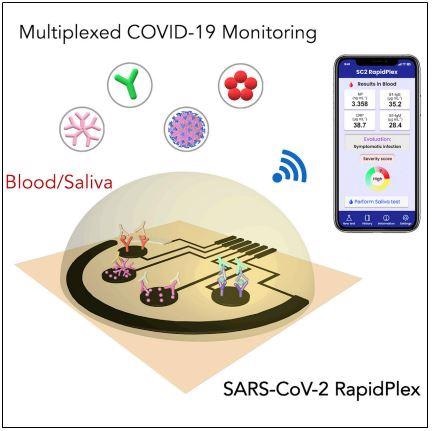
The SARS-CoV-2 RapidPlex . Image Credit: ‘SARS-CoV-2 RapidPlex: A Graphene-based Multiplexed Telemedicine Platform for Rapid and Low-Cost COVID-19 Diagnosis and Monitoring,’ Matter, [https://www.cell.com/matter/fulltext/S2590-2385%2820%2930553-1]
Researchers from CalTech have developed a standalone low-cost COVID-19 test that can deliver results in 10 minutes, at home, even for people showing no symptoms.
A major battle in the war against COVID-19, a virus that has both impacted our very way of life and has thus far cost almost 2 million lives, is diagnosis. Now a research team from the Calfornia Institute of Technology (CalTech) could have struck a major blow in this battle.
The team has devised a standalone electronic unit — the SARS-CoV-2 RapidPlex — which is highly tuned to COVID’s specific biochemical tags. This could enable ‘on the spot’ testing, identifying the presence of the virus within 10 minutes. This gives it a major advantage over current methods, which can take hours, or even days, to produce a result.
The unit even delivers a diagnosis for people who show no symptoms at the time of testing. This could make a significant difference in combating a virus that is easily spread by asymptomatic carriers.
What makes the SARS-CoV-2 RapidPlex unit even more impressive is the fact that it is comprised of a combination of low-cost sensors, potentially making it fairly economical to produce. Further to this, the unit processes the collected data and reports its results to the user's smartphone, making it adaptable and transportable. Crucially, it means the unit can also be operated without the need for a medical professional, thus, users can deploy the test in their homes.
One of the reasons the unit is so efficient is that it can electrochemically identify three important molecular biomarkers. Namely, the virus itself, the immune response antibodies created to combat it, and a protein that is linked to inflation, the detection of which can indicate the severity of the infection.
Consequently, the SARS-CoV-2 RapidPlex unit can detect COVID-19 from extremely low-levels of specific components in bodily fluids like blood, saliva, and even sweat.
This is the only telemedicine platform I’ve seen that can give information about the infection in three types of data with a single sensor. In as little as a few minutes, we can simultaneously check these levels, so we get a full picture of the infection, including early infection, immunity, and severity.
Wei Gao, Lead Researcher and Assistant Professor, Department of Medical Engineering, CalTech
The researchers discuss their potential breakthrough in a paper published in the journal Matter¹.
Graphene Sensors Hunt Down COVID-19 Biomarkers
One of the keys to the SARS-CoV-2 RapidPlex unit’s efficiency is its sensors and the material that coats them. The unit’s sensor array has four graphene electrodes, a silver/ silver-chlorine electrode, and a graphene counter electrode, all of them laser-engraved on a substrate of polyimide.
Antigens and antibodies are immobilized on laser engraved micropores carved into the graphene electrodes. As well as ensnaring these molecules, the micropores mean that the sensors have a large surface area, meaning that even when working with minuscule samples, the proteins employed by the SARS-CoV-2 RapidPlex are delivered enough material to detect the presence of COVID-19.
The sensor’s surface area also benefits from the use of graphene, which has a large surface area due to the fact it consists of a single layer of carbon atoms. Graphene also allows electrons to move across and through it pretty much unimpeded. This high-charge mobility grants the unit high sensitivity and the ability to switch sensing strategies.
Graphene grants another benefit to devices that employ it; the fact that is both cheap and abundant. Coupled with the fact that both of the laser engraving stages involved in the process of creating the sensors that comprise the SARS-CoV-2 RapidPlex are fast and cost-effective, this means the unit should be both economical and mass-producible.
The result is a convenient tool for the rapid, accurate, and stage-specific detection of COVID-19 infection.
Moving the SARS-CoV-2 RapidPlex Out of the Lab
Currently, the SARS-CoV-2 RapidPlex is in the lab-testing stage of its development. Though it has demonstrated impressive results that Gao says indicate high sensitivity, these were produced with small samples. Thus, the unit must now prove itself with larger samples.
The CalTech team will now look at testing the SARS-CoV-2 RapidPlex with ‘real-world’ samples collected directly from patients, rather than lab-prepared samples obtained from patients that have already tested positive or negative.
All this means moving the SARS-CoV-2 RapidPlex from the laboratory to hospitals, and following this, embarking on ‘at home’ testing.
Our ultimate aim really is home use. In the following year, we plan to mail them to high-risk individuals for at-home testing. And in the future, this platform could be modified for other types of infectious disease testing at home.
Wei Gao, Lead Researcher and Assistant Professor, Department of Medical Engineering, CalTech
References
¹ Gao. W., Torrente-Rodríguez. R. M., Lukas. H., et al, [2020], ‘SARS-CoV-2 RapidPlex: A Graphene-based Multiplexed Telemedicine Platform for Rapid and Low-Cost COVID-19 Diagnosis and Monitoring,’ Matter, [DOI: 10.1016/j.matt.2020.09.027]
Disclaimer: The views expressed here are those of the author expressed in their private capacity and do not necessarily represent the views of AZoM.com Limited T/A AZoNetwork the owner and operator of this website. This disclaimer forms part of the Terms and conditions of use of this website.